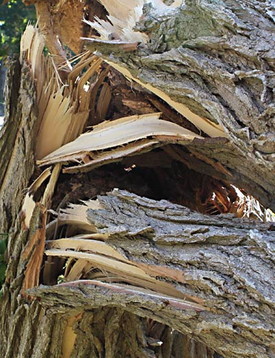 Winter is the time of year to look to your trees. Are they safe and sturdy? Or are they hazardous? In my town, a child was killed in his driveway by a branch that fell.
Winter is the time of year to look to your trees. Are they safe and sturdy? Or are they hazardous? In my town, a child was killed in his driveway by a branch that fell.
What does hazardous mean exactly? Are there big dead or dying branches that could fall on the electric wires, the house, the car, or worse, on a person? Are there big trees that could fall over during a storm? They can do enormous damage.
How can you tell? What should you look for? First, trees should be well balanced, with a good center of gravity. Look at the main branches. They should balance the weight evenly, all around. Are some branches too long or too heavy? Should some branches be pruned back and shortened for better stability?
On the trunk, look for rot, big holes or big decayed sections. Even more important, look for mushrooms, Yes, fan-shaped mushrooms. These usually indicate decay inside the tree.
 Then look at the big, heavy branches. Are they leaning over your roof or driveway? If one cracked in another windstorm or hurricane, where would they fall?
Then look at the big, heavy branches. Are they leaning over your roof or driveway? If one cracked in another windstorm or hurricane, where would they fall?
To see if they are unhealthy, look at the ends. Dying branches have very little twiggy growth at their ends. They do not have a lot of dense, healthy small branches.
If in doubt, call a Certified Arborist to give you an opinion. Not just a lawn guy who owns a power saw. All states have professional tree organizations and have lists of well trained professionals. Or ask your town Tree Warden or town maintenance department for names.
And if you hire anyone with a power saw, or who climbs trees, be sure to look at his liability insurance coverage, otherwise, if someone gets hurt, you could be sued.
Our weather and storms are getting more violent, and more and more trees are broken. In the worst storm last year, 68 public town trees in my town were destroyed in one day.
Fortunately few wires were brought down because the tree maintenance department went out after the weather was reported, but before the storm, and did preventative pruning.
The local Garden Club donated money to help replant the trees that were lost during bad storms last year. Local clubs, all kinds, not just garden clubs, have been a major source of funding for much significant tree planting and town beautification in many cities and towns.
Also useful for cities and towns is a Shade Tree Committee, made up of tree and landscape professionals who contribute their technical expertise to the town. I have served on one for many years in my town. Tree Wardens who know every street tree in town are most important for their years of experience and expert judgement.
Towns can save money by planting bare-root trees which cost much less than bigger, balled and burlaped specimens. They need staking. However, they can be planted by knowledgeable town park or tree maintenance crews, rather than more expensive contract crews.
When planting trees, it ix very important to make sure that the main roots are spread out, and not allowed to grow around the tree. Encircling roots don’t look like much when they are small, but after some years, they will thicken and choke the tree.
Surprisingly, after 5 years the bare-rooted trees are bigger, and have a better survival rate. This is because there is less root shock when trees are smaller. Also bigger trees that are dug, then put into burlap ( or even plastic) root-balls suffer from having many of their roots cut in the digging process.
Burlap can be left on the tree ball when planting for it will decay. However plastic "burlap" which looks the same as natural burlap will never decay and will cause the decline and eventual death of the tree.
Ruth S. Foster is a landscape consultant and arborist. More gardening
information can be found on her website, www.mothersgarden.net.
Credit: www.mothersgarden.net




























